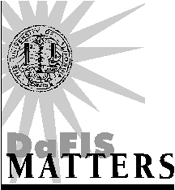

The Path to System Enhancements by Lia Scott
DaFIS, the Davis Financial Information System, is well into its second year, and we have already released several software upgrades. Many changes were directly requested by users. Generally speaking, critical and non-critical system enhancements follow a process driven by user needs and input.
Identifying a Need
Possible changes to the system (Transaction Processing or Decision Support) are initiated in one of these main ways:
- A member of the the Functional Users Group reports a problem or need directly related to the individual's job function, or identified through campus feedback mechanisms.
- The Customer Advisory Team (CAT) receives input from users in the division or school that they represent and defines a change request.
- The DaFIS Help Desk identifies a need based on calls received from staff.
If a bug or enhancement is identified as a critical emergency (for data integrity, system performance, or a critical business function), it is assigned to a developer. After extensive testing, the change is released into Production as soon as is practical.
All non-critical bugs and enhancements go through a much more comprehensive evaluation.
The Review
The Customer Advisory Team and the Functional Users Group review all of the outstanding change requests. These two groups are charged with prioritizing the requests based on:
- The greatest overall impact on users
- The importance of the change for conducting the university's business
- Whether it fills a need not previously met.
The DaFIS project manager and development manager are given this combined list for evaluation. Based on this list and available resources, they determine the scope of the next release. This truncated list is presented to the Steering Committee, along with the preliminary schedule, for review and final acceptance.
User Input is Critical
To date, enhancements to DaFIS have all come from some form of user input. Examples of enhancements driven by user feedback include:
- Commodity Code searches. The search screen was improved based on user surveys and communication with Purchasing.
- Changes during routing. This functionality was identified by the CAT as a high priority based on user input.
- Transaction Listing with Payroll Detail. Through extensive interviews with users, the DaFIS Assessment Task Force identified this recent enhancement as users' highest priority. This report was conceived and designed to meet the specific needs of Principal Investigators.
It is only through the collaborative efforts of campus and Accounting & Financial Services staff (including the DaFIS Team) that DaFIS can succeed. Without this collaboration, the system could not continue to improve.
To determine who is your CAT representative, visit the DaFIS Web site, http://accounting.ucdavis.edu/DaFIS/. The CAT page contains a list of all committee members, by school or division, and the members of the subcommittees.
Lia Scott, from Accounting and Financial Services, can be contacted by email at liascott@ucdavis.edu.